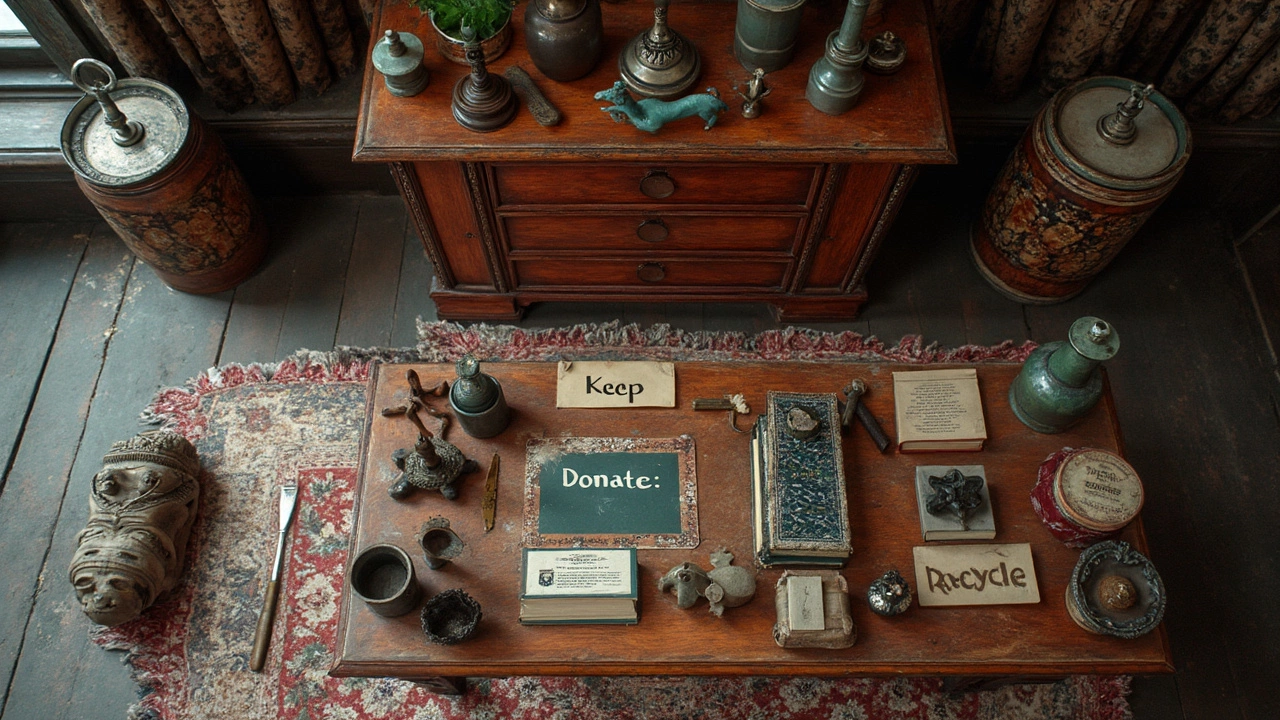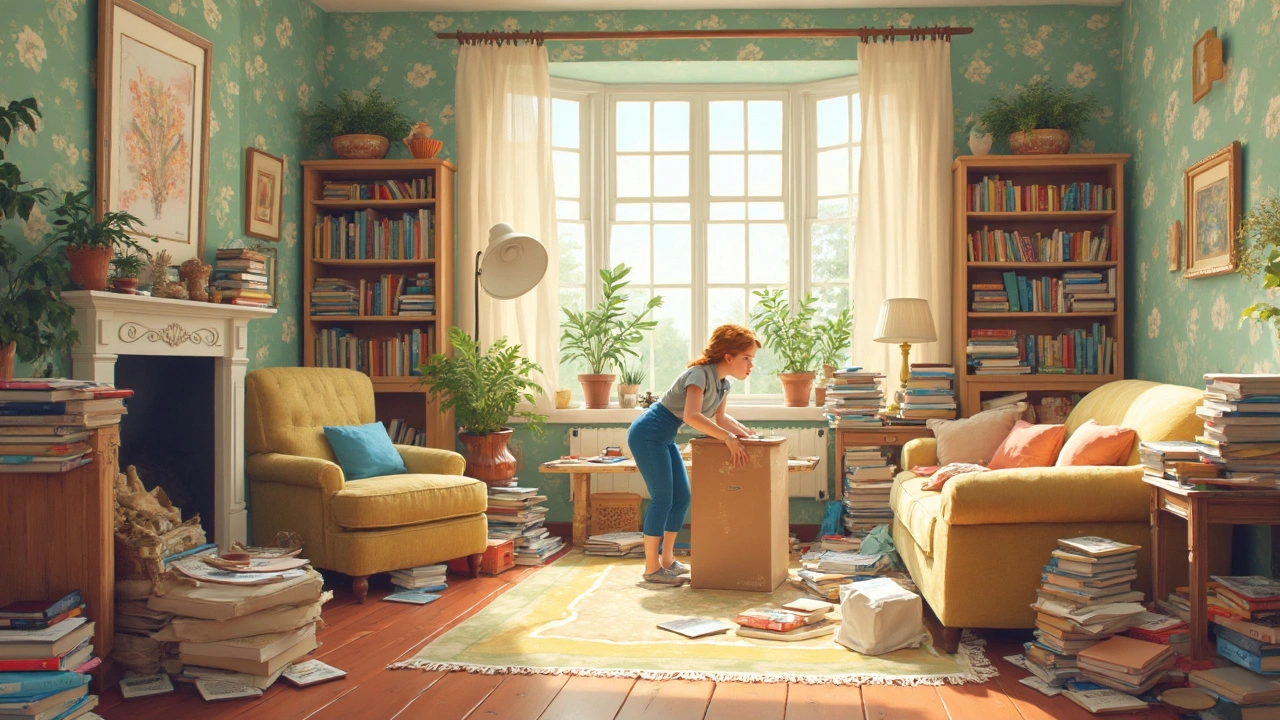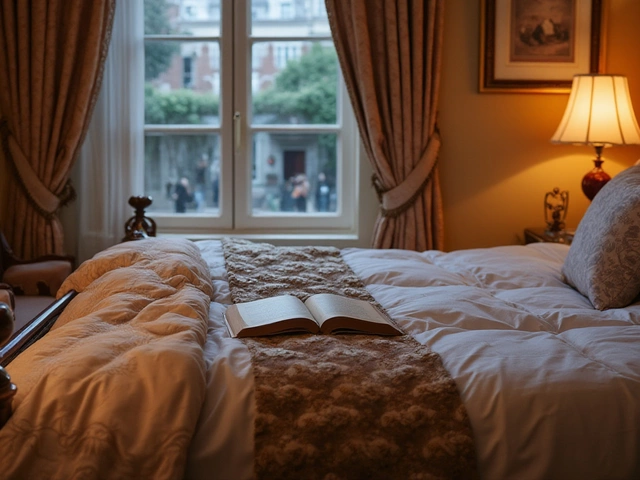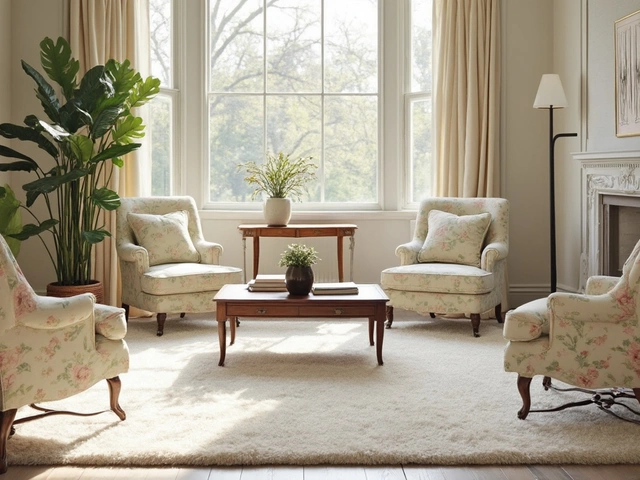Decluttering a room can feel like climbing a mountain, especially if you're staring down a space brimming with stuff. So, how long does it really take? The quick answer: it depends. Factors like room size, the amount of stuff, and your own pace play huge roles. But don’t panic. There’s a method to the madness and breaking it down step-by-step can make it manageable.
Start with setting realistic goals. Maybe you give yourself a weekend for a bedroom or just an afternoon for the closet. Time yourself during a session to get a better idea of how long you take for specific tasks. A pro tip: listen to upbeat music or podcasts to make it more fun. You might be surprised at how time flies when you're entertained!
- Breaking It Down: Room by Room
- Time-Saving Tips and Tricks
- Essential Tools for Decluttering
- Maintaining Clutter-Free Spaces
Breaking It Down: Room by Room
When it comes to decluttering, breaking the process down into smaller, manageable parts is the way to go. Each room has its own unique challenges and set of priorities, so let’s dive into some practical tips for tackling each one.
Living Room
The living room often serves as the central hub of the home, so it's easy for stuff to pile up. Start by tackling the visible clutter: old magazines, remote controls, or that growing stack of mail. Once the surface areas are clear, move onto hidden storage like cabinets or entertainment centers.
- Set a timer for 25 minutes and see how much you can tackle within that period.
- Focus on one category of items at a time, like books or electronics.
- Finish by vacuuming or dusting to give the room a fresh look.
Bedroom
Bedrooms should be a peaceful retreat, but too often they become dumping grounds for clothes and miscellaneous items. Start with the closet – it’s usually where most of the clutter hides. Sort through clothes and make three piles: keep, donate, and discard.
- Limit yourself to two hours per session to avoid burnout.
- Use garment bags or bins to store seasonal clothing.
- Keep a box for donation near your door for easy drop-offs.
Kitchen
Kitchens can become cluttered quickly, what with all the cooking gadgets and pantry items. Begin by going through each cupboard and drawer, discarding expired foods and duplicate gadgets.
| Gadget | Average Use per Month |
|---|---|
| Blender | 10 times |
| Air Fryer | 5 times |
| Slow Cooker | 3 times |
Seeing how often you use kitchen gadgets in a storage solutions context can guide you on what needs to be kept out or stored away.
Bathroom
Bathrooms, though small, can hide a surprising amount of clutter. Check expiration dates in your medicine cabinet and toss out anything past its prime. Sort through cosmetics and toiletries; if you haven’t used it in six months, it’s probably time to let it go.
- Invest in drawer dividers to keep things organized.
- Create a rotation system for toiletries to use the oldest first.
- Consider transparent bins under the sink for easy access.
Tackling each room methodically helps create a more organized and functional space. Plus, seeing progress in one room can motivate you to move on to the next. Remember, it's all about finding what works best for your lifestyle while keeping your environment clutter-free.
Time-Saving Tips and Tricks
Tackling decluttering can be a breeze with a few handy tips up your sleeve. Let’s face it, time is precious, and nobody wants to spend days knee-deep in clutter. Here’s how to speed up the process while keeping it efficient and even a little fun.
Set a Timer
Commit to decluttering in short bursts. Set a timer for 15 to 30 minutes, and focus solely on one task. It’s amazing what you can achieve with a little pressure and a looming deadline. This also prevents burnout, so you're more likely to stick with it.
The Three-Box Method
Before you start, grab three boxes labeled 'Keep,' 'Throw Away,' and 'Donate.' As you go through items, quickly decide which box each item belongs in. This method keeps you from getting bogged down in indecision and helps maintain momentum.
Start Small
Begin with a small space, like a drawer or a shelf. Completing a small area first gives you a sense of accomplishment and motivates you to tackle bigger projects with confidence.
Enlist Help
Rope in family or friends for a decluttering party. More hands mean faster work, and they can offer honest opinions on what to keep and what to toss. Throw on some music, and it might even be fun!
Use Effective Storage Solutions
Smart storage solutions can be the unsung hero of decluttering. Think under-bed storage, over-the-door racks, or clear containers that stack neatly. Keep frequently used items accessible, and store seasonal or rarely used items out of the way.
Check out this quick breakdown:
| Task | Estimated Time |
|---|---|
| Set Timer for Focus Burst | 15-30 minutes |
| Three-Box Sorting | Varies by space, 10-15 minutes per small area |
| Declutter Small Space | 5-10 minutes |
| Organize with Storage Solutions | 30-60 minutes |
These strategies are all about working smarter, not harder, keeping your room organization process quick and painless.

Essential Tools for Decluttering
Tackling clutter can be daunting, but with the right tools, you'll feel empowered and ready to conquer any chaotic space. Let's dive into some must-haves that you might not have considered yet.
1. Sorting Containers
First up, get yourself some good sorting containers. You need at least three: one for items to keep, one for donations, and one for trash. Reusable shopping bags work wonders here because they're easy to carry around and can stand up on their own.
2. Label Maker
A label maker can be your best friend when organizing. Once you've decided what stays, labels help you remember where everything goes. This ensures each item has its own home, making it easier to maintain a clutter-free environment.
3. Storage Bins and Baskets
Think about storage solutions that not only de-clutter but also suit your room's décor. Investing in a few stylish storage bins or baskets can make a world of difference. They're perfect for neatly stashing away seasonal clothes, extra blankets, or kids' toys, while also keeping things within reach.
4. Cleaning Supplies
Once you've cleared the clutter, don't skip the cleaning part. Wipes, dusters, and vacuum cleaners help you get your space spotless. A clean room feels much more inviting and functional.
5. Donation Tracker
If you're serious about giving back while decluttering, keep a list or spreadsheet of items you're donating. It not only helps you keep track of what you've given away, but it's also useful for tax purposes. Plus, it feels pretty rewarding to see how much you're donating!
Bonus: Color-Coding System
For those of you who are visually oriented, a color-coding system can simplify the process significantly. Use colored sticky notes or tape to mark sections of the room that require different actions, like red for things to remove and green for items that stay.
These essential tools make the battle against clutter not just easier, but also a bit more enjoyable. It's all about making it work for you and your lifestyle with some smart planning and the right equipment.
Maintaining Clutter-Free Spaces
Once you've put in the hard work to declutter, the last thing you want is for stuff to start piling up again. Keeping a room clutter-free is all about making smart habits stick. It sounds easy, but anyone who's battled clutter knows it's a real challenge. So how can you maintain the order?
Regular Tidying
Make it a habit to spend just 10-15 minutes a day on quick tidying. This could mean making your bed, putting away dishes, or sorting through the mail. Quick daily tasks help stop messes before they start.
One In, One Out
For every new item that enters a room, commit to removing one. If you buy a new shirt, donate an old one. This practice keeps things from slowly creeping back in and overwhelming your space.
Utilize Smart Storage Solutions
Proper storage can be a game changer. Use clear bins for easy visibility and label everything. Floating shelves can also free up floor space and keep things organized without looking messy.
Monthly Check-In
Set aside a little time each month to assess what's working and what's not. Are there items you've never touched? Be ruthless—if it's not serving you, it's time to say goodbye.
Finally, remember that maintaining these spaces isn’t a one-time deal. It’s an ongoing process that requires a little effort but makes life a lot more relaxed. If you keep at it, you’ll find your clutter-free spaces stay that way much longer.







